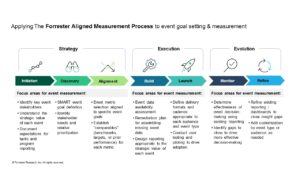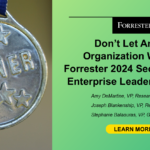Spending on B2B events is perennially one of the largest items on the CMO’s budget, with upwards of 30% of program spend going on event activity. High spend demands accountability: According to Forrester’s Q1 2024 State Of B2B Events Survey, the number one priority for event teams over the next 12 months is demonstrating ROI. However, effective event measurement is hard with teams facing a number of hurdles.
The five principal challenges of event measurement
- A failure to agree on clear, measurable goals. Too many event teams still treat goal setting as an afterthought. This leads to wooly, high-level goals that fail to align with wider business and marketing objectives. And when events lack clear goals, teams don’t know what to measure. As one leader we spoke to said, “event measurement becomes about justifying existence versus showing impact’.
- A focus on logistics, not business outcomes. For many event teams their primary focus is event delivery and logistics. This risks the team getting relegated to operational delivery, with strategic decisions being taken elsewhere. The end result is a disconnected goal-setting process and poor event measurement.
- Misaligned event stakeholders. Large scale tier one events typically have multiple stakeholders, each with a different perspective on the primary objective of the event. Teams struggle to obtain agreement between these stakeholders, which results in poor alignment, competing goals, and uncertainty around what to measure.
- The complexity of calculating event ROI. The growing complexity of B2B buying means that we shouldn’t be judging an event attendee as the single source of an opportunity. Multiple decision-makers need to be engaged, and enterprise opportunities may take years to translate into revenue. This means an in-year ROI calculation is fraught with challenges and will likely fail to adequately represent the value an event delivers.
- Siloed and unintegrated event technology. Effective event measurement requires the quick and seamless flow of event data from event technology platforms into the CRM. But according to Forrester data, only 21% of enterprises have fully integrated their event platform into their tech stack, which makes it difficult to access the data needed for effective measurement.
Apply the Forrester Aligned Measurement Process to your event measurement

We recommend applying the Forrester Aligned Measurement Process to event measurement. This process lays out seven repeatable steps for teams to follow to produce reporting deliverables tightly aligned to business objectives and customized for key event stakeholders.
Forrester clients can access the new report, ‘Mastering B2B Event Measurement,’ and accompanying event metric template which lists a wide range of example metrics for different event types. Clients can also request a guidance session to review their event goal-setting, learn how to apply the Aligned Measurement Process, and start showcasing the value of their events!








